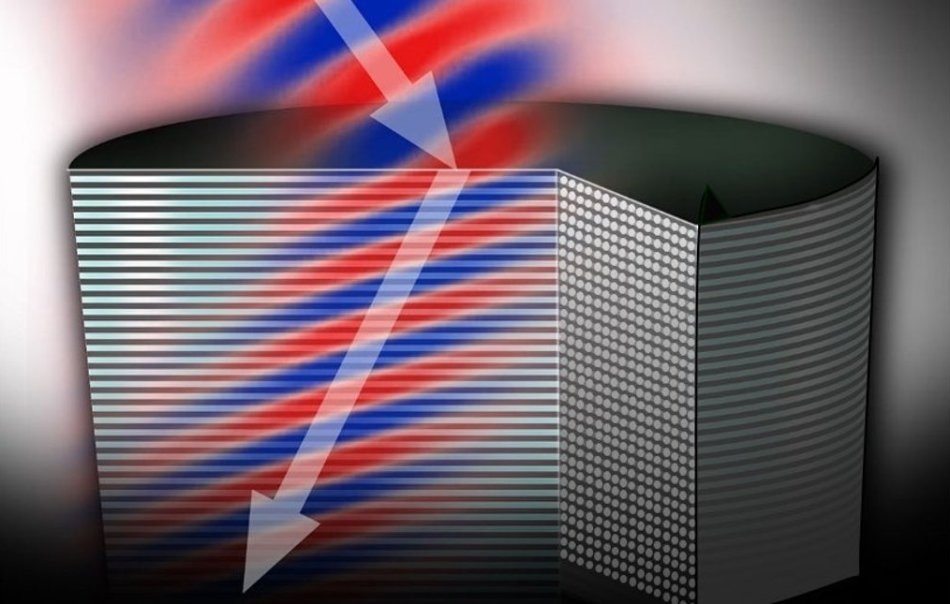Nov 7 2017
In order to transform invisibility cloaks and other such gee-whiz apps from science fiction to scientific reality, in-depth knowledge of the functioning of these unconventional metamaterials is mandatory. Elena Semouchkina, a Michigan Tech scientist, has revisited the fundamentals and has thrown more light on the physical aspects of this magic.
 The shape and positioning of the rods in this metamaterial cause light (the arrow) to bend at a negative angle, a process called negative refraction. Better understanding of this dynamic will speed the development of new metamaterials such as perfect lenses and invisibility cloaks, says Michigan Tech’s Elena Semouchkina. CREDIT: Illustration by Navid Ganji.
The shape and positioning of the rods in this metamaterial cause light (the arrow) to bend at a negative angle, a process called negative refraction. Better understanding of this dynamic will speed the development of new metamaterials such as perfect lenses and invisibility cloaks, says Michigan Tech’s Elena Semouchkina. CREDIT: Illustration by Navid Ganji.
Metamaterials puts forward the prospect of making our most unbelievable fancies real some day. The super-power applications of the metamaterials—such as invisibility cloaks, perfect lenses, and extremely powerful batteries—tantalize the imagination. This being the case, thus far, “tantalize” is the key word as researchers have been investigating metamaterials for over one and a half decades.
“Not many real metamaterial devices have been developed,” stated Elena Semouchkina, an associate professor of electrical engineering at Michigan Technological University. Soldiers in the battlefield cannot wear invisibility cloaks to evade sniper fire, and none of the perfect lens apps allows us to observe viruses by using a smartphone. To a certain extent, this is due to the fact that conventionally, scientists excessively simplify the functioning of metamaterials. According to Semouchkina, the complications of metamaterials have often not been considered.
Therefore, she and her colleagues endeavored to probe these complications and found out that the super-power of the metamaterials is due to more than one physical mechanism. A paper reporting the study was recently published in the online version of the Journal of Physics D: Applied Physics.
Simple!
According to Semouchkina, although metamaterials appear to be complicated and futuristic, the reality is just the opposite. Metamaterials, the name in which “meta” is the Greek word for “beyond”, are engineered materials with characteristics not observed in nature. They are normally formed of a number of similar elements fabricated from traditional materials like nonconductive materials or metals. Imagine a Rubik’s cube formed of millions of units smaller when compared to the thickness of a strand of human hair.
The designer materials function by bending the electromagnetic radiation paths, from radio waves through visible light to high-energy gamma rays, in innovative and disparate ways. The way the metamaterials bend the paths (i.e. a process known as refraction) steers their atypical applications. For instance, an invisibility cloak made with the metamaterial will bend the paths of light waves around an object enclosed by the cloak, speed them up on their path and reunite them on the rear side. This makes an onlooker to see the things behind the object, whereas the object itself is rendered invisible.
The traditional strategy of metamaterials scientists has been to correlate the refractive characteristics of a metamaterial with resonance. When electromagnetic radiation enters the metamaterial, every tiny building block of the material vibrates similar to a tuning fork, giving rise to the desired kind of refraction.
But not that simple . . .
Semouchkina was curious whether there are other factors that cause bending of the paths of the waves.
“Metamaterials seem simple, but their physics is more complicated,” stated Semouchkina, describing how she and her colleagues concentrated on dielectric metamaterials, which are formed of elements that do not conduct electricity.
The researchers ran a number of computer simulations and arrived at an astonishing finding that the refraction was affected by the periodicity of the materials, that is, the shape and repeated organization of the building blocks in the metamaterial. Resonance played a very small or no part in it.
The metamaterials analyzed by the team had the properties of another kind of artificial material, namely, photonic crystals. Similar to metamaterials, photonic crystals are formed of numerous identical cells. Moreover, they function similarly to semiconductors used in electronics, except for the fact that they emit photons in the place of electrons.
We found that the properties that go along with being a photonic crystal can mask the resonance of metamaterials, to the point they can cause unusual refraction— including negative refraction, which is necessary for the development of a perfect lens.
Elena Semouchkina, an associate professor of electrical engineering at Michigan Technological University
Back to Basics
Therefore, what is the inference for the engineers and researchers developing futuristic super materials?
“Basically, we need to recognize that some of these structures can exhibit properties of photonic crystals, and we need to take their physics into account,” stated Semouchkina. “It’s an evolving field, and it’s a lot more complicated than we’ve given it credit for.”
Semouchkina and her colleagues are striving to create invisibility cloaks by using photonic crystals. However, she reiterates that metamaterials analyses can find different real-world applications. One of her research works aims at applying metamaterial concepts to enhance magnetic resonance imaging (MRI) sensitivity, which might culminate in better medical diagnostics and progresses in biological studies.
“This is a very practical outcome, compared to the Harry Potter stuff,” stated Semouchkina.
In-depth knowledge of the basic physical concepts of metamaterials will accelerate the creation of such devices.
Semouchkina, PhD candidate Navid P. Gandji, and Research Professor George Semouchkin, all from Michigan Tech’s Department of Electrical and Computer Engineering, were the authors of the new paper.